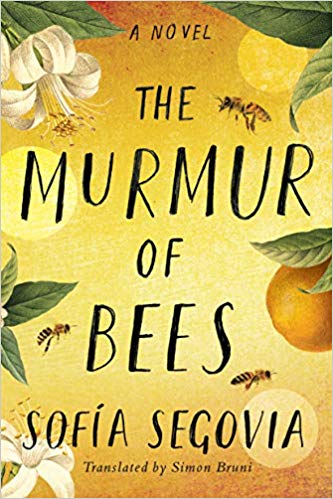The Murmur of Bees
- By Sofía Segovia; translated by Simon Bruni
- Amazon Crossing
- 476 pp.
- Reviewed by Sally Shivnan
- May 23, 2020
Love endures in this hypnotic Mexican tale of triumph, tragedy, and magic.

A magical-realism romp from Mexico, Sofía Segovia’s The Murmur of Bees — her first novel translated into English — offers a dizzying swirl of history, family lore, tragedy, redemption, and, of course, magic. It’s the kind of magic that Latin American authors have developed to a high and subtle art, and it infuses every page of this saga.
The magic is miraculous and strange but also woven into the fabric of everyday life: A mysterious language between brothers; the sudden appearance of a young woman who has lost her newborn just when a motherless baby needs nursing; a fever with no cause, which becomes a signal that will rescue a household from death.
And the event that starts it all: the discovery, under a bridge, of an infant cloaked in a humming, gentle blanket of bees.
The Morales family names him Simonopio and raises him as their own. He turns out to have superpowers: He can see the future, which lets him help the family at crisis moments, first in the devastating 1918 flu epidemic and, later, when they risk losing their land in the wake of the Mexican Revolution.
The way he saves the land happens in typical, enigmatic Simonopio style when he appears before Francisco Morales with a handful of orange blossoms and wordlessly offers them. He never speaks because he has a cleft palate — and perhaps because he simply chooses not to. Francisco understands this gift and knows immediately what to do to save his family and their way of life.
But Simonopio is human, too. Magic in our world cannot protect us from everything, not from our own flaws or from evil. The novel seems deeply interested in the problem of evil, how and why it develops, and how powerless we are against the tragedies it brings.
Evil in this book comes in the form of a tenant farmer who turns bitter and vengeful with the years. While author Segovia is clearly on the side of the Morales family, she is not unsympathetic to the landless farmer, whose worldview has been shaped by centuries of inequality and indifference.
A complicated picture of Mexico emerges. We see a society that understands magic and miracles as a part of life, but sees also that political upheaval, violence, and endless, wrenching class struggles are part of it, too.
The magic is the novel’s great charm. The image of Simonopio, always with a bee or two alighting on him, is striking. We’re told these look like moles on his cheek or throat, except they move around. Another strong image is of Simonopio asleep in the shed he has turned into a bedroom, snoozing underneath the rafters to which his warm, murmuring hive clings through the night.
Simonopio’s lifelong partnership with the bees is as sweet as the honey they share with him. The greatest miracle of all, though, is the most elemental, mysterious act of magic early in the novel: the love the Morales family extends to the abandoned infant. The neighbors view the baby with suspicion, but the power of love is transcendent.
Readers used to brisk, dialogue-driven novels — typical fare in the U.S. — may find themselves challenged by the leisurely pace of much of this book. It’s worth surrendering to Segovia, though, and sinking into these pages because she’s very good at what she does, and her writing is lovely.
Francisco Junior’s childhood memories of days with Simonopio give a sense of the warmth and ease of that writing. Hearing familiar music transports him back “to giant-height on Simonopio’s shoulders, to warm days swimming in the river, to the toads that croaked at nightfall, to the summertime cicadas, to the orange-tree mazes, to the footstep of a bee on my face, and to its sound when it flew off.”
Simon Bruni’s translation, although it misses in minor ways in a few places, conveys Segovia’s wonderful prose very well.
Multiple narrators move in a seamless way through the chapters, an approach that is especially effective as the book builds to its powerful climax, with each shift of narrator adding another piece to our understanding of what is happening, while simultaneously making us wait for the inevitable. In these later pages, the story is irresistible.
Descriptions of landscape are something the book could use more of to pull together the cornfields, orange groves, towns glimpsed from train windows, caves, slopes, and canyons. These settings are included but not detailed in the ways that would provide a sense of this place as a whole. This may be more an issue for American readers than for Mexican ones, who, perhaps, take this area of northeastern Mexico for granted geographically.
Sofía Segovia is a bestselling author in her native country, a contemporary voice putting her own stamp on the tradition of magical realism associated with Gabriel García Márquez, Isabel Allende, and others.
The Murmur of Bees is a chance for readers north of the border to see Mexico today through the lens of the past and, as Simonopio says, “to listen to what life sometimes murmurs into your ear, heart, or gut.”
[Editor's note: This review originally ran in 2019.]
Sally Shivnan is the author of the short-story collection Piranhas & Quicksand & Love. Her fiction and essays have appeared in the Georgia Review, Antioch Review, Glimmer Train, and other journals, and her travel writing has been featured in anthologies including Best American Travel Writing, as well as in the Washington Post, Miami Herald, Nature Conservancy Magazine, and many other publications. She teaches at University of Maryland Baltimore County (UMBC).

